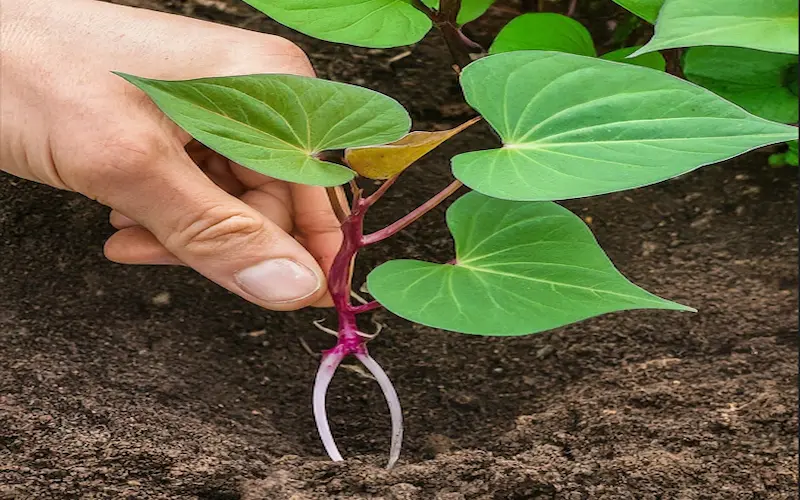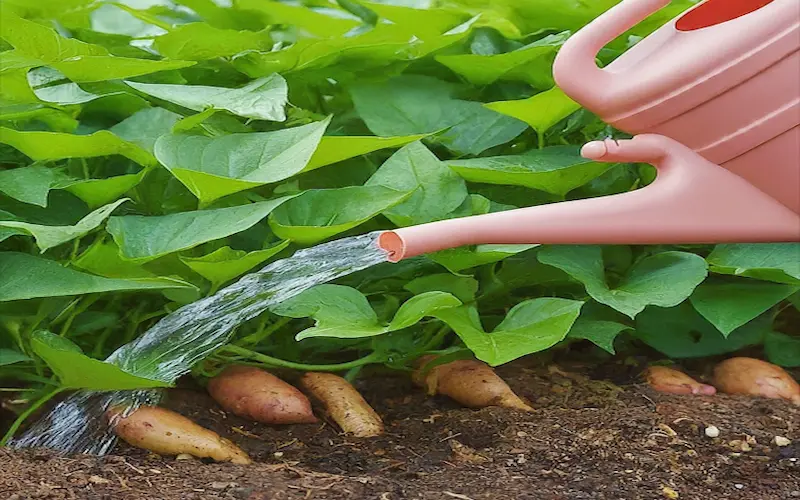How to Grow Sweet Potatoes Successfully: Ultimate Guide
Published: 14 Apr 2024
Sweet potato is a root vegetable with a sweet taste and creamy texture. It belongs to the Convolvulaceae family and is native to the Americas. Sweet potatoes are known for their vibrant orange flesh, but they can also be found in other colors like purple and white. They are nutritious food rich in vitamins, minerals, and fibre, making them a popular choice in various cuisines worldwide. Sweet potatoes can be baked, boiled, roasted, mashed, or even turned into fries, pies, and desserts.
As someone who has spent countless hours with my hands in the soil, nurturing these vibrant plants from slips to harvest, I’m excited to share my comprehensive guide on how to grow sweet potatoes successfully. Let’s delve into the art of sweet potato cultivation, exploring the nuances that can help you achieve an abundant harvest.

Right Time for Planting
Timing is everything in gardening, and sweet potatoes are no exception. These heat-loving plants thrive in warm soil, so it’s crucial to plant them optimally. In my experience, the best time to grow sweet potatoes is once the danger of frost has passed and the soil temperature has consistently reached at least 65 degrees Fahrenheit. This typically means waiting until late spring or early summer in most regions.
In the first few years of my sweet potato endeavors, I learned the hard way that planting too early can stunt growth and increase disease susceptibility. Conversely, planting too late can mean that your sweet potatoes won’t have enough time to mature before the first frost of autumn. Therefore, check local frost dates and monitor soil temperatures to pinpoint the best planting window for your area.

Soil Preparation
Preparing the soil correctly is a critical step that sets the stage for your sweet potatoes to flourish. These tubers prefer well-drained, sandy loam soil with a slightly acidic pH between 5.5 and 6.5. Before planting, I conduct a soil test and amend the soil based on the results. Adding compost or well-rotted manure can improve soil structure and fertility, which sweet potatoes appreciate.
Additionally, creating raised beds or ridges can enhance drainage and warmth, both of which sweet potatoes favor. I typically form about 8 inches high and space mounds 3 to 4 feet apart. This gives the plants ample room to spread and prevents water from pooling around the roots, which can lead to rot.
Plant Sweet Potato Slips
Sweet potato slips, young shoots grown from mature sweet potatoes, are the starting point for most sweet potato crops. I’ve found that purchasing slips from a reputable supplier or growing my own from organic sweet potatoes yields the best results. When planting, I gently place each slip into a hole deep enough to cover the roots and the lower part of the stem, then firm the soil around it.
It’s important to space the slips about 12 to 18 inches apart along the raised beds or ridges. This spacing encourages robust growth and allows each plant enough room to develop a substantial root system. After planting, I water the slips thoroughly to settle the soil and help them establish.
Allow Sweet Potatoes Vines to Grow Larger
Once the sweet potato slips are in the ground, their vines will spread and grow vigorously. Contrary to some beliefs, allowing the vines to grow unhindered can contribute to more considerable tuber development. The extensive foliage captures sunlight and channels energy into the roots, which swell into the sweet potatoes we harvest.
I’ve noticed that keeping the vines healthy and free from pests and diseases is crucial during this stage. Regular inspections and organic pest control methods can improve the overall health of the plants. Additionally, gently training the vines to grow within the allotted space can prevent overcrowding and ensure that each plant receives adequate sunlight.

Watering
Proper watering is vital to growing sweet potatoes that are both flavorful and sizable. These plants prefer deep, infrequent watering sessions, encouraging the roots to grow deeply into the soil. I aim to water my sweet potato beds once a week, providing about 1 inch of water each time. During particularly hot or dry periods, I may increase the frequency slightly.
Overwatering can be as detrimental as underwatering, so I’m careful not to saturate the soil. Excess moisture can lead to root rot and other issues that compromise the health of the plants. A good rule of thumb is to check the soil moisture by sticking a finger into the ground; if the top inch is dry, it’s time to water.

Harvesting
Knowing when to harvest sweet potatoes is an art in itself. Depending on the variety, the tubers can be harvested 90 to 120 days after planting. I watch for signs that they’re nearing maturity, such as the yellowing and dying back of the vines.
Harvesting too early can result in smaller, underdeveloped sweet potatoes while waiting too long can expose them to frost damage or pests. I usually plan my harvest for a dry day in late summer or early fall, which allows me to gently lift the tubers from the soil without them becoming too damp.
How to Harvest
The harvest process requires a gentle touch to prevent bruising or damaging the sweet potatoes, which can lead to spoilage. I use a broad or spading fork to loosen the soil around the plants, then carefully lift the tubers by hand. I avoid using sharp tools around the sweet potatoes to minimise cuts and wounds.
Once harvested, I gently brush off any excess soil without washing the tubers, as moisture can encourage decay. Any damaged sweet potatoes should be set aside for immediate consumption, as they won’t store well.

Curing
Curing sweet potatoes is a critical step that I never skip. This process allows the skins to toughen and the flavors to sweeten, enhancing their storage life. I cure my sweet potatoes in a warm, humid environment (about 85 degrees Fahrenheit and 85% humidity) for 10 to 14 days. A simple way to create these conditions is to use a small room with a space heater and humidifier.
Storing
After curing, I store the sweet potatoes in a cool, dark, and well-ventilated area with temperatures around 55 to 60 degrees Fahrenheit. Properly cured and stored sweet potatoes can last for several months, ensuring a steady supply of this delicious and nutritious root vegetable throughout the winter.
Questions and Answers related to How to Grow Sweet Potatoes
How long do sweet potatoes take to grow?
Sweet potatoes typically take about 3 to 4 months to grow from planting to harvest.
do sweet potatoes grow underground ?
Yes, sweet potatoes grow underground.
how long to harvest sweet potatoes ?
Sweet potatoes are usually ready to harvest about 3 to 4 months after planting once the vines have turned yellow and died.
Conclusion
In conclusion, growing sweet potatoes successfully requires attention to detail and a willingness to learn from the soil and plants. Following the tips outlined in this guide, you can master the art of sweet potato cultivation and enjoy the fruits. Remember to choose the right planting time, prepare the soil correctly, plant healthy slips, allow vines to grow, water wisely, harvest at the right time, and gently cure and store your sweet potatoes properly.

- Be Respectful
- Stay Relevant
- Stay Positive
- True Feedback
- Encourage Discussion
- Avoid Spamming
- No Fake News
- Don't Copy-Paste
- No Personal Attacks



- Be Respectful
- Stay Relevant
- Stay Positive
- True Feedback
- Encourage Discussion
- Avoid Spamming
- No Fake News
- Don't Copy-Paste
- No Personal Attacks



